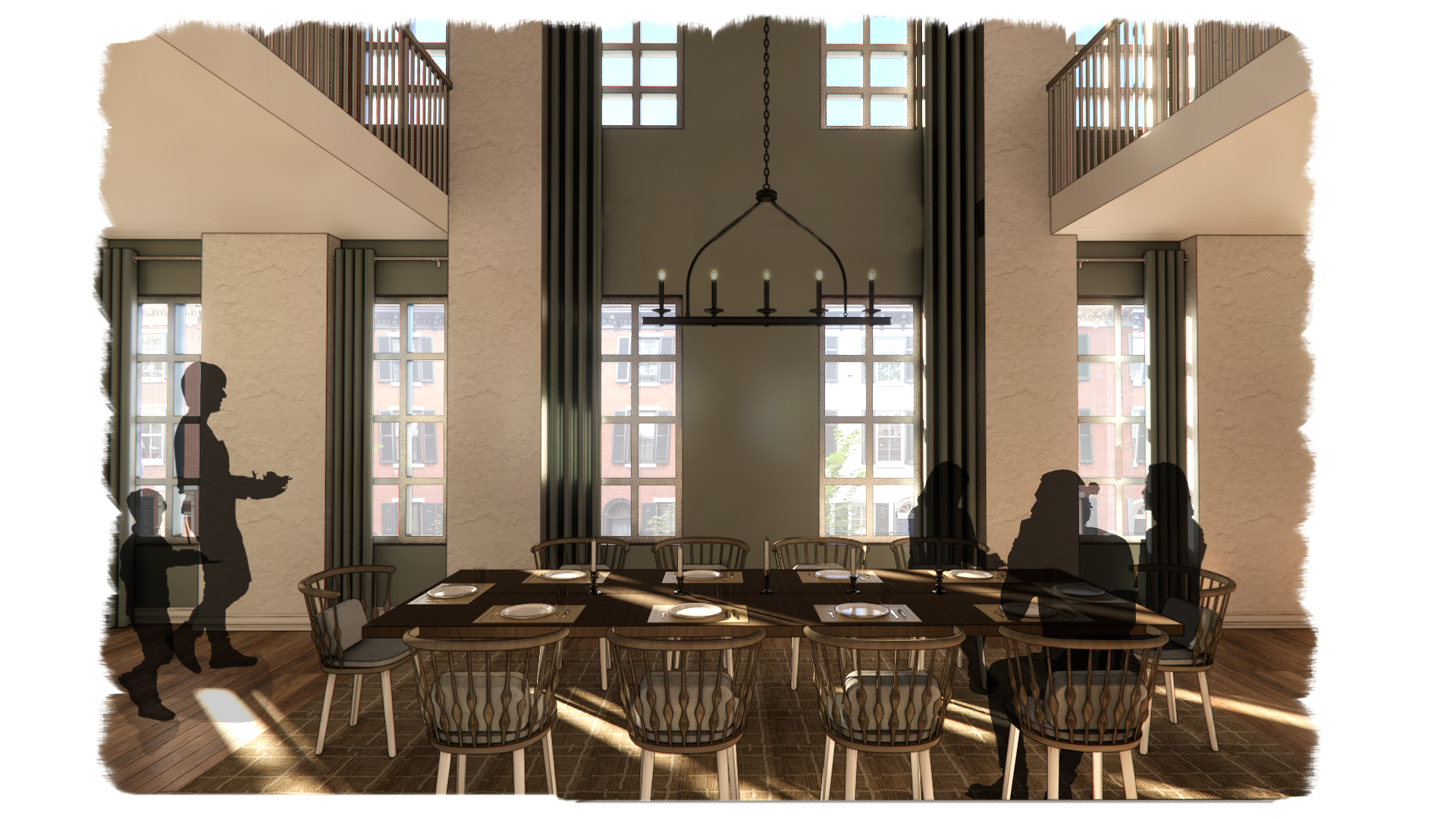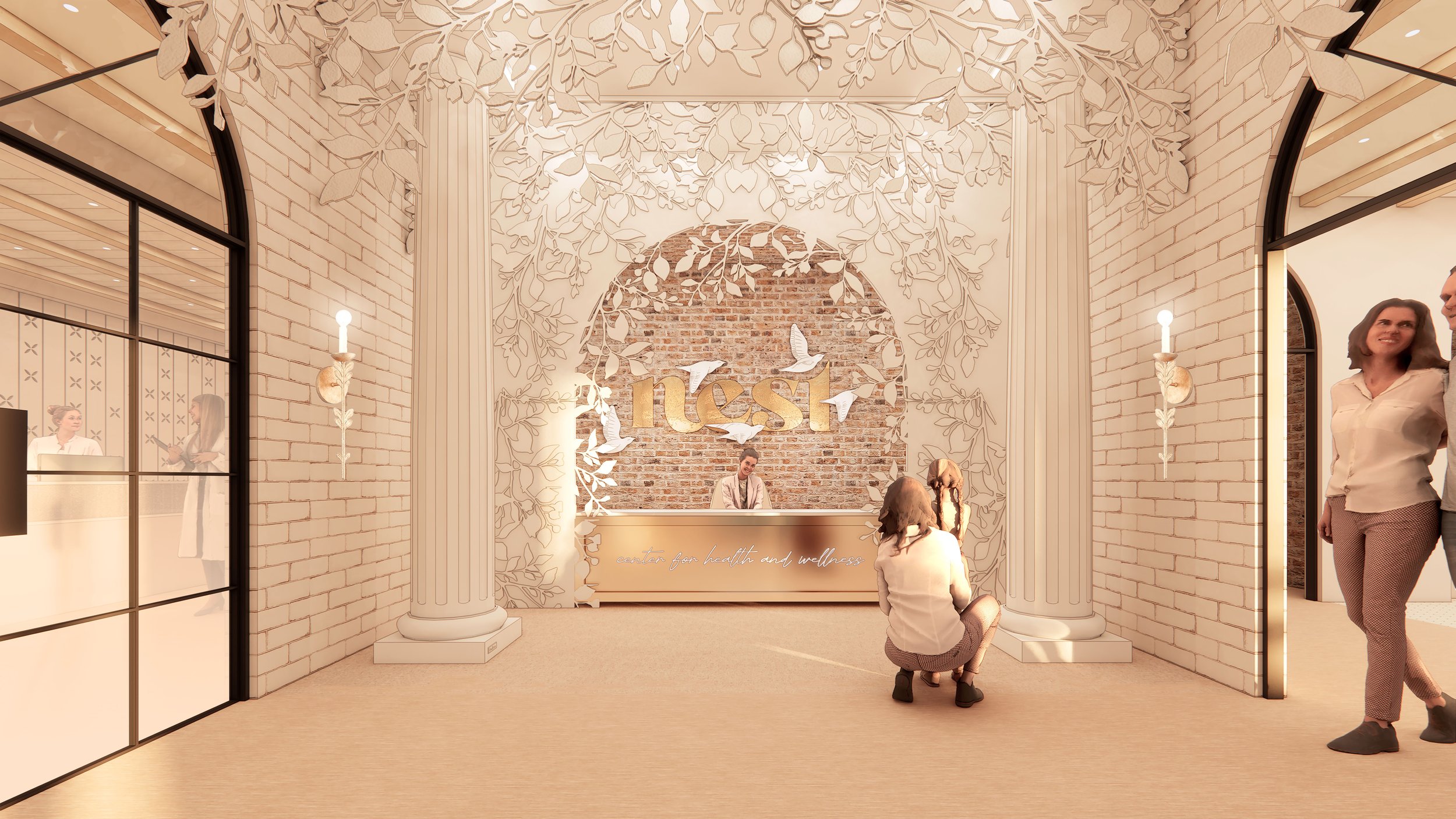Thesis Projects
Thesis Projects by Year
Children's Joyful Hospice Care to Feel Like Any Other Child
Children's hospice care is dedicated to providing compassionate and comprehensive support to children facing life-limiting illnesses with a prognosis of six months or less. This thesis proposes a groundbreaking design concept for children's hospice care, prioritizing individualized care and emotional support through the integration of nature, flexible spaces, vibrant aesthetics, and holistic sensory elements. By creating a sanctuary where children can rediscover the joys of childhood, even in the face of serious illness, the design aims to nurture the well-being of every child while providing unwavering support to families and caregivers. The proposed concept seeks to transform hospice care into a place of joy, comfort, and positive memories for both children and their families, emphasizing holistic sensory wellness, community engagement, and compassionate design principles.
Reflective Effect: Materiality Impact on Embodied Cognition in Experience Design
Exploring the relationship between humans and the environment by combining reflective materials and immersive design. This project focuses on how architectural/interior designs use reflective surfaces to transform spaces and explores the growing prominence of reflection in the human experience. These surfaces' symbolic and illusionary aspects blur the traditional boundaries between internal and external characteristics. It can bridge the gap between the occupants and the surrounding space and is a spatial phenomenon that allows people to observe themselves in their surroundings. Moreover, reflective materials in interior spaces create engaging and immersive user experiences by taking advantage of our embodied cognition. These materials aid in the physical body’s complete immersion in its environment. By designing intuitive interfaces responsive to our physical experiences, we can create more dynamic spaces that reflect our embodied experiences.
Mindful Consumption: A Rethinking of Shopping Experience
Consumerism is not only devastating our natural resources, but it also diminishes individual well-being. Rather than enhancing well-being, the expanding populations of high consumption societies are likely to have adverse effects. Even when we buy the things we really wanted, we start to want more. Fulfilling our desires never seems to satisfy us; we continually seek more happiness. Mindfulness is strongly and positively connected to higher happiness. In the context of consumption, mindfulness leads to consumer mindfulness. shopping is an activity that involves a range of practices such as experiencing public spaces, “hanging out,” and wandering around. As such, it can be understood as a leisure activity in its own right that does not necessarily involve the actual purchase of goods. I will explore various aspects related to habits, consumerism, sustainability, and the concept of a futuristic shopping experience that goes beyond traditional retail spaces, to provide education and encourage thoughtful consumption.
Beyond Shelter: Navigating the In-Between with Third Spaces for Individuals Experiencing Homelessness
Individuals experiencing homelessness exist in a dichotomy that is enforced by stereotypes and manifests in a limited scope of services, even in major metropolitan cities like Philadelphia. Homeless vs. Housed – it is a distinction that dictates the types of environments people can, or should, inhabit. For individuals experiencing homelessness, shelter is not the only solution. Spaces for the in-between, that are designed for a population in transition in order to help them heal, establish stability, and create networks within their communities, are missing. This project aims to bridge this gap through the design of an interconnected network of third spaces designed to support and empower individuals experiencing homelessness at three scales: individual, group, and community. Spaces that treat all people with dignity and respect, meeting people where they are currently instead of waiting for them to navigate crises alone, is an essential first step to fostering stronger, healthier, and more inclusive communities for all.
There’s No Place Like Home: Uniting Generations, Celebrating Cultures, and Embracing Expression
The foundation of my thesis is grounded through the central theme of the concept of “home” as it’s understood through the lens of cultural traditions. A person’s home acts as a source of emotional security, comfort, and a profound sense of belonging. It serves as the foundation for building relationships and creating memories. My thesis outlines a study that seeks to deepen our understanding of the concept of home through an exploration of cultural traditions passed down through generations. My thesis employs the theoretical framework of place-identity to examine how an individual’s sense of belonging is intertwined with their cultural heritage. By utilizing this concept, my thesis focuses not only to understand how cultural traditions contribute to individuals' sense of place-identity but also to actively create a space for the exchange and preservation of these traditions. This space is envisioned as inclusive and welcoming, fostering intergenerational dialogue and the sharing of personal narratives among individuals who share similar cultural values.
Beyond Birth: Crafting Supportive Postpartum Environments
There are 3 million pregnant women in the United States each year, and many feel like candy wrappers: packaging to be discarded after use. American apathy towards the female experience after birth is reflected in our lack of standardized postpartum care. This has contributed to one of the highest maternal death rates among the developed world, with more than half occurring after birth. According to the WHO, many of these deaths are preventable with proper postpartum care. This thesis explores the role of interior design in providing this crucial support, aiming to improve outcomes for both mothers and infants.
Unlocking Creativity: The Transformative Influence of Playscape Facilities on Children’s Emotional, Cognitive and Identity Making
In the times where children are increasingly engaging in less physical play, my thesis focuses on the immersive integration of children in environments that prioritize exploration and creativity through the strategic design of 'Playscape' facilities. These purposefully crafted environments play a crucial role in fostering imagination, problem-solving skills, and overall cognitive and emotional development during the critical early years of a child's life. The profound link between physical spaces, furniture, and developmental outcomes underscores the importance of creating spaces that actively promote creativity and contribute significantly to a child's holistic growth. Moreover, these playscapes serve as inclusive spaces where parents can spend quality time with their children, fostering a strong parent-child bond and supporting the child's development in a shared, nurturing environment.
Recreating Episodic Memories Through Immersive Environments
This thesis investigates how architectural design elements evoke emotional responses, influence the encoding and retrieval of episodic memories, and engage sensory perception within built environments. By analyzing the impact of spatial configuration, lighting, materials, colors, and sensory stimuli on emotional experiences, the research aims to elucidate the mechanisms underlying memory formation and the creation of memorable architectural experiences. Ultimately, this research contributes to a deeper understanding of the relationship between architecture, emotion, and memory, with implications for the design of more enriching and impactful built environments.
The Blue Interior: A Future Speculation on Acceptance of Rising Tides
Beaches and shorelines are some of humanity’s most treasured places. However, sea level rise as a consequence of climate change threatens to erase these communities from the map entirely. And, even in the face of destruction, the choice to leave one’s generational home is a difficult one. I argue that instead of simply running from rising waters, the more proactive solution is to design intentionally in-place, preserving the history of our treasured beach towns. As we grapple with the reality of encroaching tides, this thesis explores the human relationship with coastal inhabitation in the context of the Jersey Shore, and reimagines living near water as living with water.
CommonRoom: Reviving Community Spirit as a Health Imperative
In today's society, the escalating loneliness epidemic underscores the need to reassess our built environment. This change acknowledges the substantial influence of our surroundings on health and social interactions, reflecting Sandro Galea's view that health is shaped by various societal and environmental factors. CommonRoom, an intergenerational mixed-use development, is crafted to enhance social connections and mitigate the loneliness epidemic prevalent in contemporary society. Drawing from an extensive place analysis in Old Delhi, the foundational guidelines of my design thesis inform both the zoning and development phases of the CommonRoom project.
Temple at Tiffany’s: Finding Meaning in Contemporary Material Culture
Temple at Tiffany’s is a set of interior interventions that explore our complicated relationship with material culture. The project examines our aspirations of luxury, and questions widely accepted symbols of status and appearances. Through carefully curated associations with personalities like Audrey Hepburn and Beyonce, Tiffany’s epitomises elegance and sophistication. Tiffany’s is a symbol of prestige that operates through mechanisms of reification, fetishization, and phantasmagoria to construct meaning and produce objects that embody wealth and power. The interventions within the flagship Tiffany’s store on 5th Avenue in NYC engage with the tension inherent in these mechanisms of status--we adore and worship these figures and objects, yet they perpetuate stark inequalities. The interventions include a dystopian take on the Tiffany Diamond, an overnight boudoir, and a luxury supermarket with Tiffany’s mass merchandise. On the 7th floor, a VIP dreamscape invites one to indulge their fantasies among the 21st century gods.
Architecture as Séance: A Dialogue Across Time
Architecture embodies both history and visions of the future. The way we inhabit old buildings then can be a form of seance: a dialogue with the ghosts of our past as a way to grapple with history and take agency in constructing heritage. Utilizing Philadelphia’s landmark brutalist Roundhouse building--former home of the Philadelphia Police Department--this thesis explores how design can amplify or subvert experiences of place and history, enabling us to reimagine our relationship with the past as an active conversation, always in progress. This project reinvents the Roundhouse as an arts ecosystem, anchored by a nightclub, which serves an artist residency program and a luxury hotel for patrons of the arts. Revealing the architectural form allows moments that invert historic dynamics of power and subjectification, instead embracing interaction and enjoyment.
The Mix: Adapting to Gentrification Through Community Place-Making
This thesis project focuses on addressing socio-economic disparities in the Chelsea neighborhood of New York City through strategic design interventions. Unlike typical gentrification that causes physical displacement, Chelsea is experiencing "emotional displacement," where long-term residents feel out of place amid rapid development. The project creates "third spaces"—community-oriented areas separate from home and work that facilitate social interaction. Key components include learning spaces like communal bookstores and tech labs, nourishment spaces such as an international food hall and community kitchen, and a laundromat café. These shared spaces are designed to foster interaction between different socio-economic groups, aiding in place-making to embrace the new neighborhood. This project aims to build community, address income inequality, and provide a sense of belonging for all residents, thereby turning the challenges of gentrification into opportunities for social cohesion.
Wildly Connected : An Approach to Fostering a Deeper Connection With Nature
In hopes to cultivate a lasting relationship and mend the disconnect between urban high school students and the natural environment, this thesis will investigate how the fusion of playful learning methodologies and immersive technology can uncover practical strategies for nurturing a sense of wonder, curiosity, and appreciation for the natural world even within the confines of densely populated areas.
Beyond the Waves: Exploring Sustainable Futures through Floating Interior Architecture in the Face of Rising Sea Levels
Facing the challenge of rising sea levels due to global warming, I aim to explore the relationship between floating architecture and its interiors. My design approach is to create an entertaining social hotspot that invites both locals and tourists to enjoy Copenhagen's water culture. The concept, "Iceberg Haven," provides experiences at different elevations of the sea level, emphasizing the urgency of addressing this environmental issue. This floating architecture adapts to changing conditions and serves an educational purpose, highlighting the impact of global warming. My thesis delves into these adaptations and the potential for floating structures to educate and engage the public















